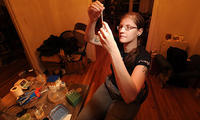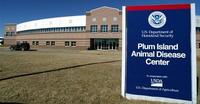-
Garage-lab bugs: spread of bioscience increases bioterrorism risks

There is a new fear about the possible source of a bioterror attack: scientific advances now enable amateur scientists to carry out once-exotic experiments, such as DNA cloning, which could be put to criminal use; as recently as a decade ago, the tools and techniques for such fiddling were confined to a handful of laboratories like those at leading research universities; today, do-it-yourself biology clubs have sprung up where part-timers share tips on how to build high-speed centrifuges, isolate genetic material, and the like
-
-
Plum Island bio lab an inviting target for terrorists

The bio lab on 840-acre Plum Island, a mile-and-a-half off Long Island’s Orient Point, is a Biosafety level 4 facility — the only type of research lab authorized to handle diseases that are communicable between humans and animals and for which there is no known cure; from a boat, terrorists armed with shoulder-fired rockets would have a clear shot, or a plane could dive into the laboratory, dispersing deadly germs into an area from Massachusetts to New York; DHS has decided to build a new lab in Kansas to replace the aging Plum Island center, but some local politicians object, citing the local jobs that would be lost
-
-
HHS seeks comments on bioterror select agents list
The biennial review required by the Public Health Security and Bioterrorism Preparedness and Response Act of 2002 is under way; comments about biological agents or toxins that should be added or removed are due by 20 August
-
-
Bioterrorism experts criticize cuts in BioShield to pay for teacher retention
In order to find funds which would prevent teacher layoffs, House Democrats craft an appropriations bill which takes $2 billion from a bioterrorism emergency program; security experts criticize what they call a lack of foresight
-
-
Finding a smallpox vaccine for the event of a bioterror attack
Smallpox is a potentially fatal and highly contagious infectious disease, estimated to have killed between 300 million and 500 million people in the first half of the twentieth century; the world was declared free of smallpox in 1980 — concern about the use of smallpox by bioterrorists spurs new research into vaccines
-
-
Vast cleanup of Plum Island land since 2000
DHS plans to sell Plum Island and replace its bio-research facilities with a brand new BioLab in Manhattan, Kansas; documents show that since 2000 there have been extensive efforts to remove vast amounts of waste and contaminants — hundreds of tons of medical waste, contaminated soil, and other refuse — from the island
-
-
Researchers sequence the human body louse
As well as irritations from infestations with body lice or the closely related human head lice, the body louse may carry harmful bacteria that cause epidemic typhus and are classified as a bioterrorism agent; U.S. and Swiss scientists have sequenced the louse genome — a major step toward controlling the disease-vector insect
-
-
Emergent sells anthrax vaccine to U.S. allies
European countries, worried about bioterror attacks, are working on a plan to stock vaccines regionally — a Baltic stockpile, a Nordic stockpile, and so on would help in covering countries that have not expressed a desire to form their own stockpiles; a Maryland-based companies is providing these European countries with anthrax vaccine
-
-
North Carolina prepares for bioterrorism, epidemics
North Carolina universities and state and federal agencies create the new North Carolina Bio-Preparedness Collaborative; the idea is to use computers to link all the disparate forms of data collected by various agencies quickly to root out indicators of new disease, or food-borne illness, or, in a worst-case scenario, an attack of bio-terrorism
-
-
Bill seeks to bolster U.S. ability to fight bioterror
Bill calls for bolstering U.S. defenses against future bioterror attacks requiring the director of national intelligence to produce and administer a National Intelligence Strategy for Countering the Threat from WMD, which would be created in consultation with the homeland security secretary as well as other relevant agencies
-
-
George Mason University opens $50 million biomedical lab to fight bioterrorism
George Mason University has opened a $50 million biomedical research laboratory as part of the U.S. effort to fight bioterrorism; research will focus on the diagnosis, prevention and treatment of infectious diseases and on pathogens the government thinks could be used in a bioterrorism attack
-
-
Botox as a bioterror threat
Botox may be used to straighten wrinkles and lift sagging body parts, but the proliferation of counterfeit Botox worldwide — fueled by consumer demand — has made the toxin, which is deadly in sufficient quantities, far more easily available for would-be bioterrorists than it was in the past
-
-
Michigan biter did not violate bioterrorism laws
A judge dismissed bioterrorism charges against an HIV-positive Michigan man who bit his neighbor during a fight; the prosecution argued that the defendant intended to infect the neighbor with the virus, thus violating Michigan bioterrorism laws
-
-
Researchers develop an Ebola vaccine
Researchers develop an experimental vaccine that cures the Ebola virus by targeting its genetic material; trouble is, the Ebola vaccine can only work if it is administered within thirty minutes, which is an impracticality among civilian populations; the vaccine is a viable possibility within a research facility, so it may be used to protect the researchers themselves
-
-
Defeating anthrax bacterium's natural defenses may hold key to new treatments
Up to 90 percent of untreated cases of inhalational anthrax result in death; Bacillus anthracis, the causative agent of anthrax, is particularly lethal because of its protective coating, or capsule, which enables the pathogen to escape destruction by the host’s immune system; researchers discover a way to “trick” the bacterium into shedding its protective covering
-
- All
- Regional
- Water
- Biometrics
- Borders/Immig
- Business
- Cybersecurity
- Detection
- Disasters
- Government
- Infrastructure
- International
- Public health
- Public Safety
- Communication interoperabillity
- Emergency services
- Emergency medical services
- Fire
- First response
- IEDs
- Law Enforcement
- Law Enforcement Technology
- Military technology
- Nonlethal weapons
- Nuclear weapons
- Personal protection equipment
- Police
- Notification /alert systems
- Situational awareness
- Weapons systems
- Sci-Tech
- Sector Reports
- Surveillance
- Transportation
Advertising & Marketing: advertise@newswirepubs.com
Editorial: editor@newswirepubs.com
General: info@newswirepubs.com
2010-2011 © News Wire Publications, LLC News Wire Publications, LLC
220 Old Country Road | Suite 200 | Mineola | New York | 11501
Permissions and Policies
Editorial: editor@newswirepubs.com
General: info@newswirepubs.com
2010-2011 © News Wire Publications, LLC News Wire Publications, LLC
220 Old Country Road | Suite 200 | Mineola | New York | 11501
Permissions and Policies
